MAZDA MODEL 3 HATCHBACK 2007 Owner's Manual (in English)
Manufacturer: MAZDA, Model Year: 2007, Model line: MODEL 3 HATCHBACK, Model: MAZDA MODEL 3 HATCHBACK 2007Pages: 402, PDF Size: 5.66 MB
Page 131 of 402
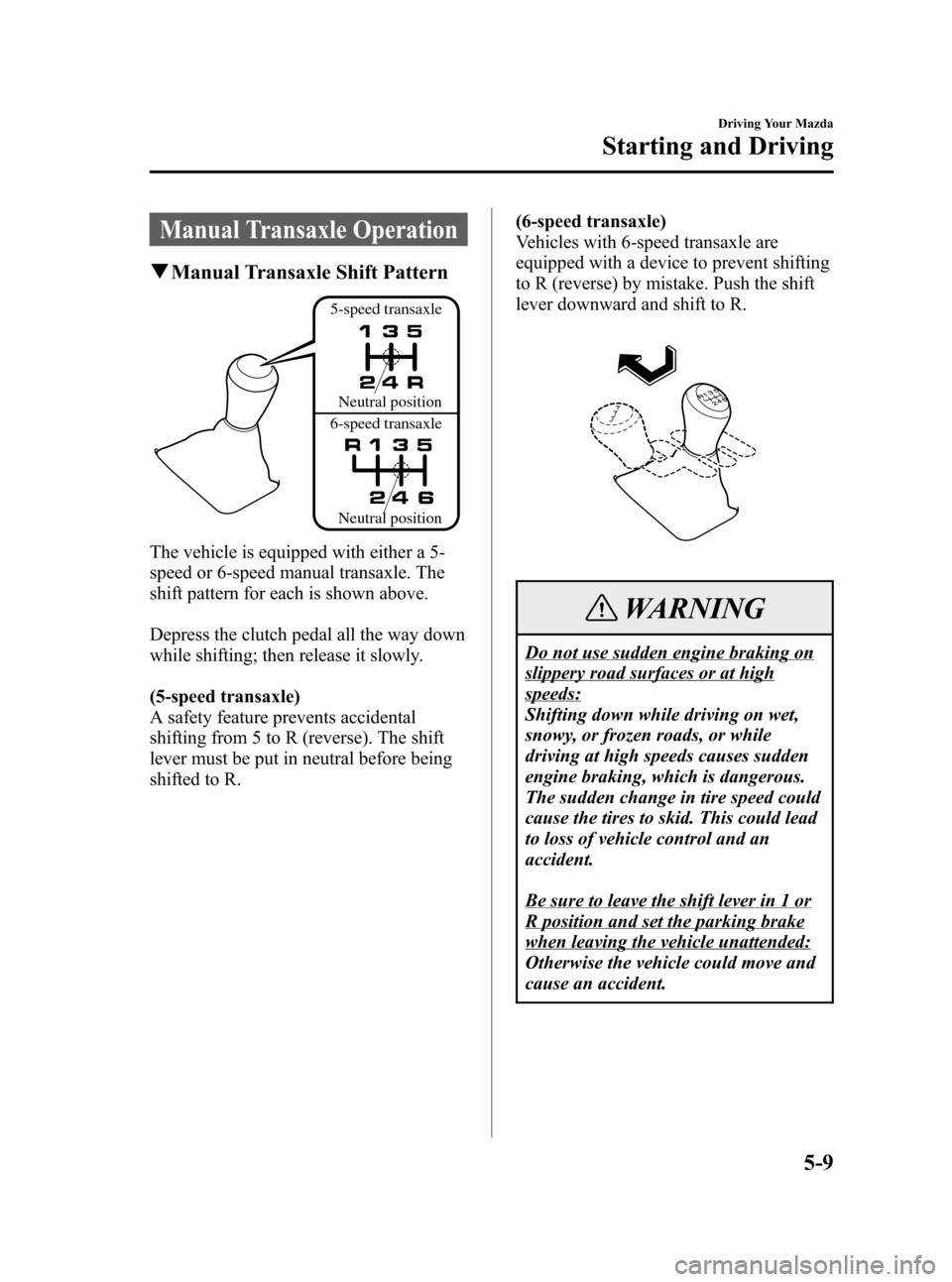
Black plate (131,1)
Manual Transaxle Operation
qManual Transaxle Shift Pattern
5-speed transaxle
6-speed transaxleNeutral position
Neutral position
The vehicle is equipped with either a 5-
speed or 6-speed manual transaxle. The
shift pattern for each is shown above.
Depress the clutch pedal all the way down
while shifting; then release it slowly.
(5-speed transaxle)
A safety feature prevents accidental
shifting from 5 to R (reverse). The shift
lever must be put in neutral before being
shifted to R.(6-speed transaxle)
Vehicles with 6-speed transaxle are
equipped with a device to prevent shifting
to R (reverse) by mistake. Push the shift
lever downward and shift to R.
WARNING
Do not use sudden engine braking on
slippery road surfaces or at high
speeds:
Shifting down while driving on wet,
snowy, or frozen roads, or while
driving at high speeds causes sudden
engine braking, which is dangerous.
The sudden change in tire speed could
cause the tires to skid. This could lead
to loss of vehicle control and an
accident.
Be sure to leave the shift lever in 1 or
R position and set the parking brake
when leaving the vehicle unattended:
Otherwise the vehicle could move and
cause an accident.
Driving Your Mazda
Starting and Driving
5-9
Mazda3_8V66-EA-06F_Edition3 Page131
Wednesday, August 23 2006 11:19 AM
Form No.8V66-EA-06F
Page 132 of 402
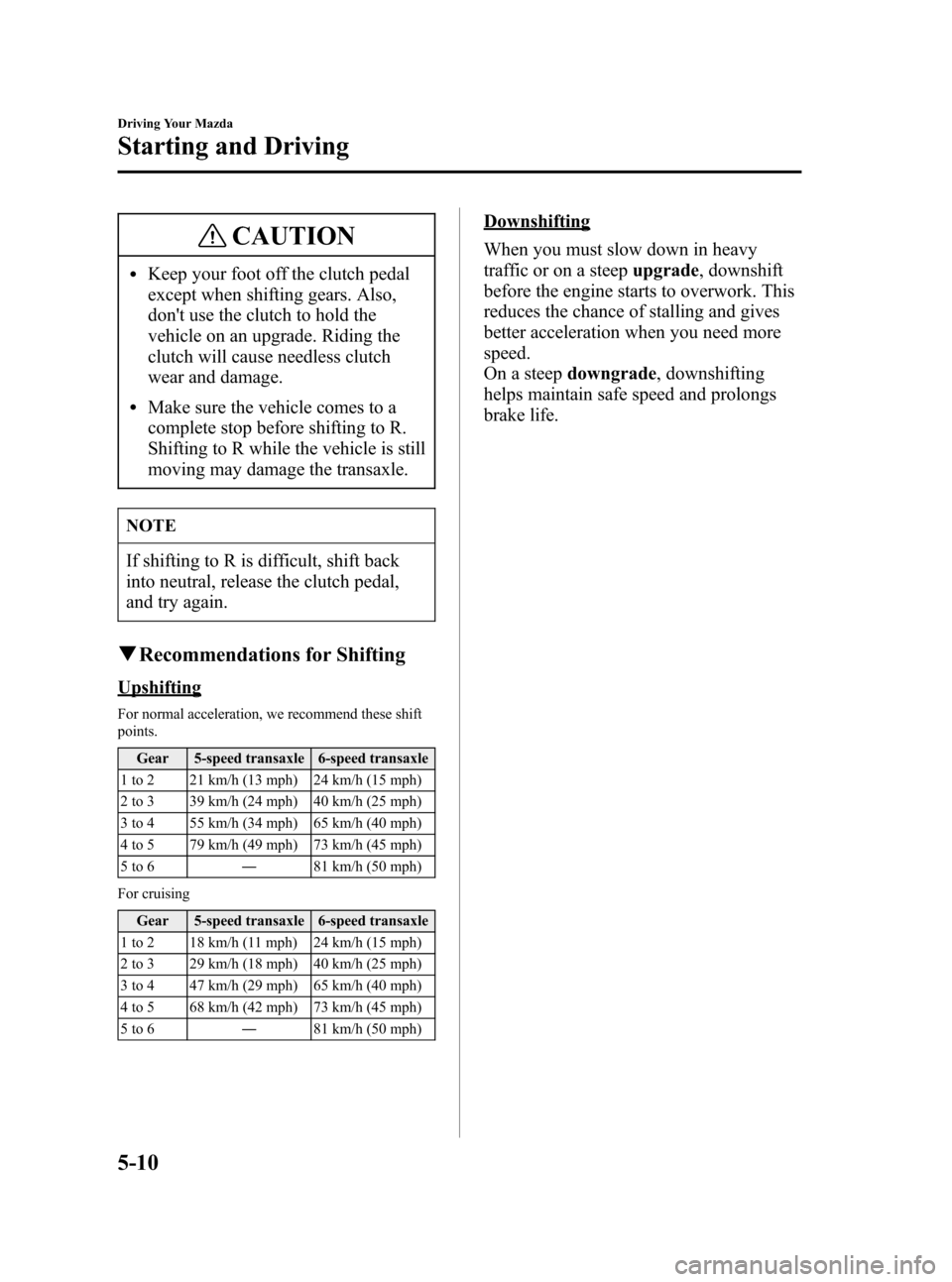
Black plate (132,1)
CAUTION
lKeep your foot off the clutch pedal
except when shifting gears. Also,
don't use the clutch to hold the
vehicle on an upgrade. Riding the
clutch will cause needless clutch
wear and damage.
lMake sure the vehicle comes to a
complete stop before shifting to R.
Shifting to R while the vehicle is still
moving may damage the transaxle.
NOTE
If shifting to R is difficult, shift back
into neutral, release the clutch pedal,
and try again.
qRecommendations for Shifting
Upshifting
For normal acceleration, we recommend these shift
points.
Gear 5-speed transaxle 6-speed transaxle
1 to 2 21 km/h (13 mph) 24 km/h (15 mph)
2 to 3 39 km/h (24 mph) 40 km/h (25 mph)
3 to 4 55 km/h (34 mph) 65 km/h (40 mph)
4 to 5 79 km/h (49 mph) 73 km/h (45 mph)
5to6―81 km/h (50 mph)
For cruising
Gear 5-speed transaxle 6-speed transaxle
1 to 2 18 km/h (11 mph) 24 km/h (15 mph)
2 to 3 29 km/h (18 mph) 40 km/h (25 mph)
3 to 4 47 km/h (29 mph) 65 km/h (40 mph)
4 to 5 68 km/h (42 mph) 73 km/h (45 mph)
5to6―81 km/h (50 mph)
Downshifting
When you must slow down in heavy
traffic or on a steepupgrade, downshift
before the engine starts to overwork. This
reduces the chance of stalling and gives
better acceleration when you need more
speed.
On a steepdowngrade, downshifting
helps maintain safe speed and prolongs
brake life.
5-10
Driving Your Mazda
Starting and Driving
Mazda3_8V66-EA-06F_Edition3 Page132
Wednesday, August 23 2006 11:19 AM
Form No.8V66-EA-06F
Page 133 of 402
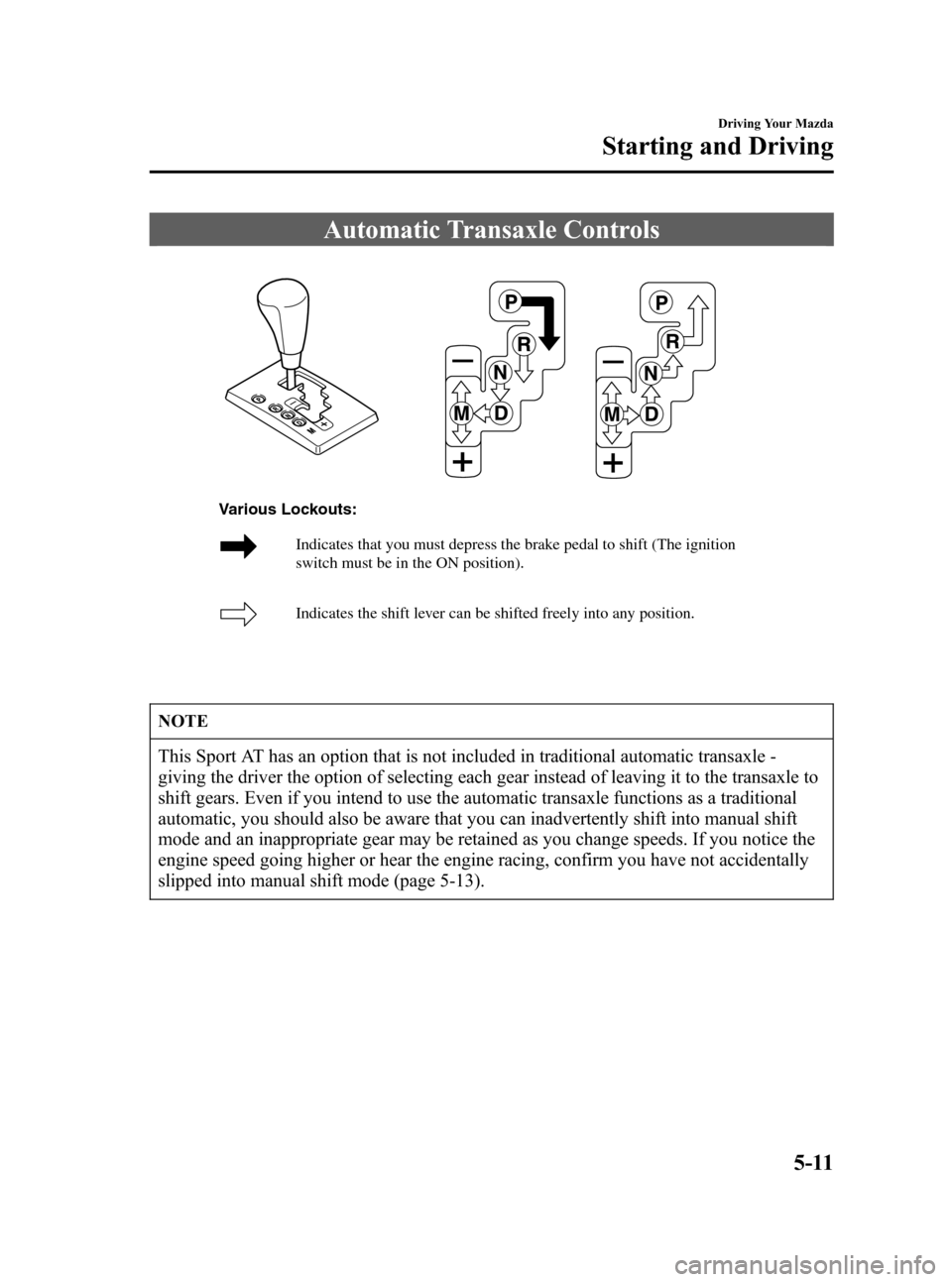
Black plate (133,1)
Automatic Transaxle Controls
Indicates that you must depress the brake pedal to shift (The ignition
switch must be in the ON position).
Indicates the shift lever can be shifted freely into any position.
Various Lockouts:
NOTE
This Sport AT has an option that is not included in traditional automatic transaxle -
giving the driver the option of selecting each gear instead of leaving it to the transaxle to
shift gears. Even if you intend to use the automatic transaxle functions as a traditional
automatic, you should also be aware that you can inadvertently shift into manual shift
mode and an inappropriate gear may be retained as you change speeds. If you notice the
engine speed going higher or hear the engine racing, confirm you have not accidentally
slipped into manual shift mode (page 5-13).
Driving Your Mazda
Starting and Driving
5-11
Mazda3_8V66-EA-06F_Edition3 Page133
Wednesday, August 23 2006 11:19 AM
Form No.8V66-EA-06F
Page 134 of 402
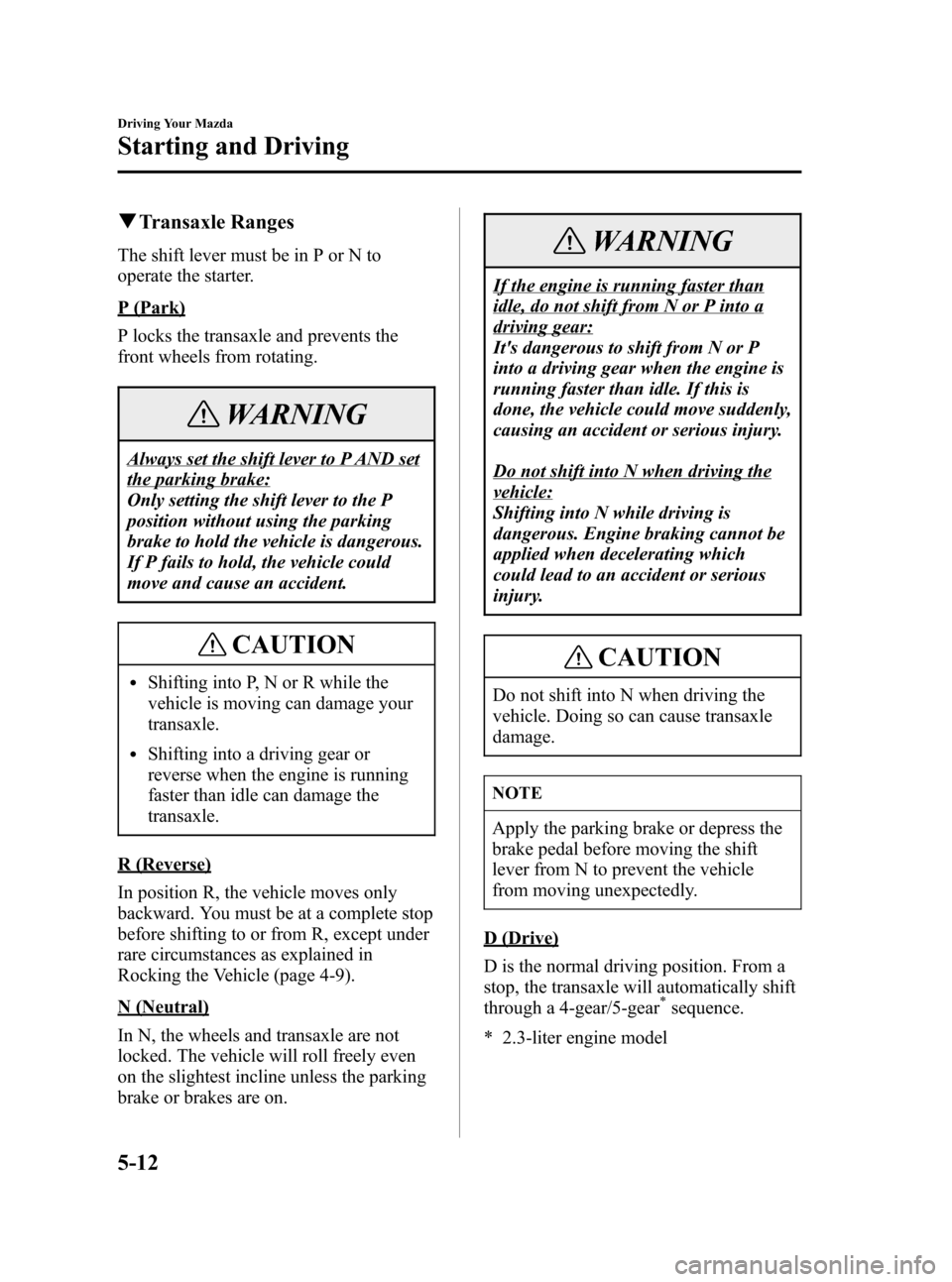
Black plate (134,1)
qTransaxle Ranges
The shift lever must be in P or N to
operate the starter.
P (Park)
P locks the transaxle and prevents the
front wheels from rotating.
WARNING
Always set the shift lever to P AND set
the parking brake:
Only setting the shift lever to the P
position without using the parking
brake to hold the vehicle is dangerous.
If P fails to hold, the vehicle could
move and cause an accident.
CAUTION
lShifting into P, N or R while the
vehicle is moving can damage your
transaxle.
lShifting into a driving gear or
reverse when the engine is running
faster than idle can damage the
transaxle.
R (Reverse)
In position R, the vehicle moves only
backward. You must be at a complete stop
before shifting to or from R, except under
rare circumstances as explained in
Rocking the Vehicle (page 4-9).
N (Neutral)
In N, the wheels and transaxle are not
locked. The vehicle will roll freely even
on the slightest incline unless the parking
brake or brakes are on.
WARNING
If the engine is running faster than
idle, do not shift from N or P into a
driving gear:
It's dangerous to shift from N or P
into a driving gear when the engine is
running faster than idle. If this is
done, the vehicle could move suddenly,
causing an accident or serious injury.
Do not shift into N when driving the
vehicle:
Shifting into N while driving is
dangerous. Engine braking cannot be
applied when decelerating which
could lead to an accident or serious
injury.
CAUTION
Do not shift into N when driving the
vehicle. Doing so can cause transaxle
damage.
NOTE
Apply the parking brake or depress the
brake pedal before moving the shift
lever from N to prevent the vehicle
from moving unexpectedly.
D (Drive)
D is the normal driving position. From a
stop, the transaxle will automatically shift
through a 4-gear/5-gear
*sequence.
* 2.3-liter engine model
5-12
Driving Your Mazda
Starting and Driving
Mazda3_8V66-EA-06F_Edition3 Page134
Wednesday, August 23 2006 11:19 AM
Form No.8V66-EA-06F
Page 135 of 402
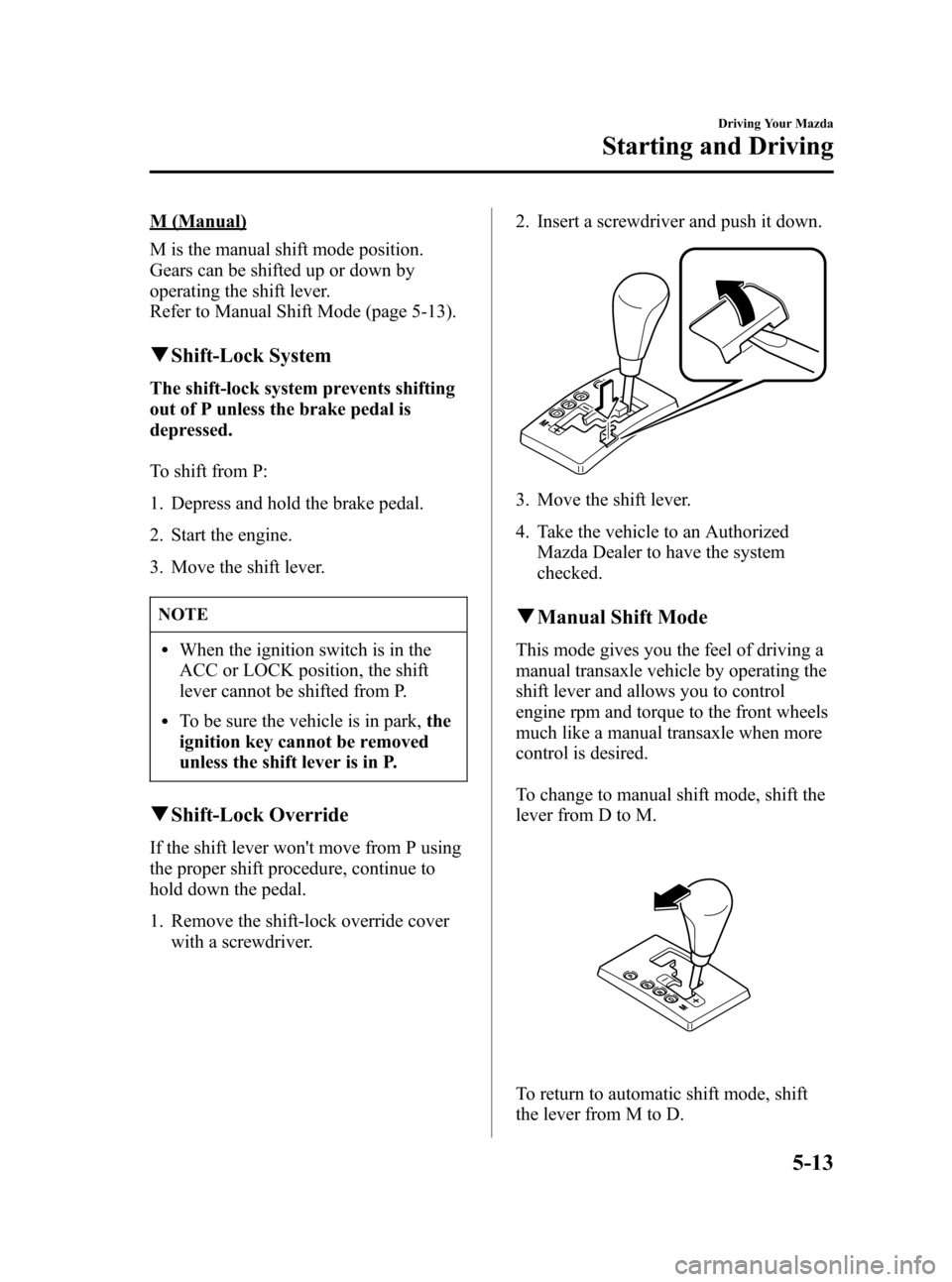
Black plate (135,1)
M (Manual)
M is the manual shift mode position.
Gears can be shifted up or down by
operating the shift lever.
Refer to Manual Shift Mode (page 5-13).
qShift-Lock System
The shift-lock system prevents shifting
out of P unless the brake pedal is
depressed.
To shift from P:
1. Depress and hold the brake pedal.
2. Start the engine.
3. Move the shift lever.
NOTE
lWhen the ignition switch is in the
ACC or LOCK position, the shift
lever cannot be shifted from P.
lTo be sure the vehicle is in park,the
ignition key cannot be removed
unless the shift lever is in P.
qShift-Lock Override
If the shift lever won't move from P using
the proper shift procedure, continue to
hold down the pedal.
1. Remove the shift-lock override cover
with a screwdriver.2. Insert a screwdriver and push it down.
3. Move the shift lever.
4. Take the vehicle to an Authorized
Mazda Dealer to have the system
checked.
qManual Shift Mode
This mode gives you the feel of driving a
manual transaxle vehicle by operating the
shift lever and allows you to control
engine rpm and torque to the front wheels
much like a manual transaxle when more
control is desired.
To change to manual shift mode, shift the
lever from D to M.
To return to automatic shift mode, shift
the lever from M to D.
Driving Your Mazda
Starting and Driving
5-13
Mazda3_8V66-EA-06F_Edition3 Page135
Wednesday, August 23 2006 11:19 AM
Form No.8V66-EA-06F
Page 136 of 402
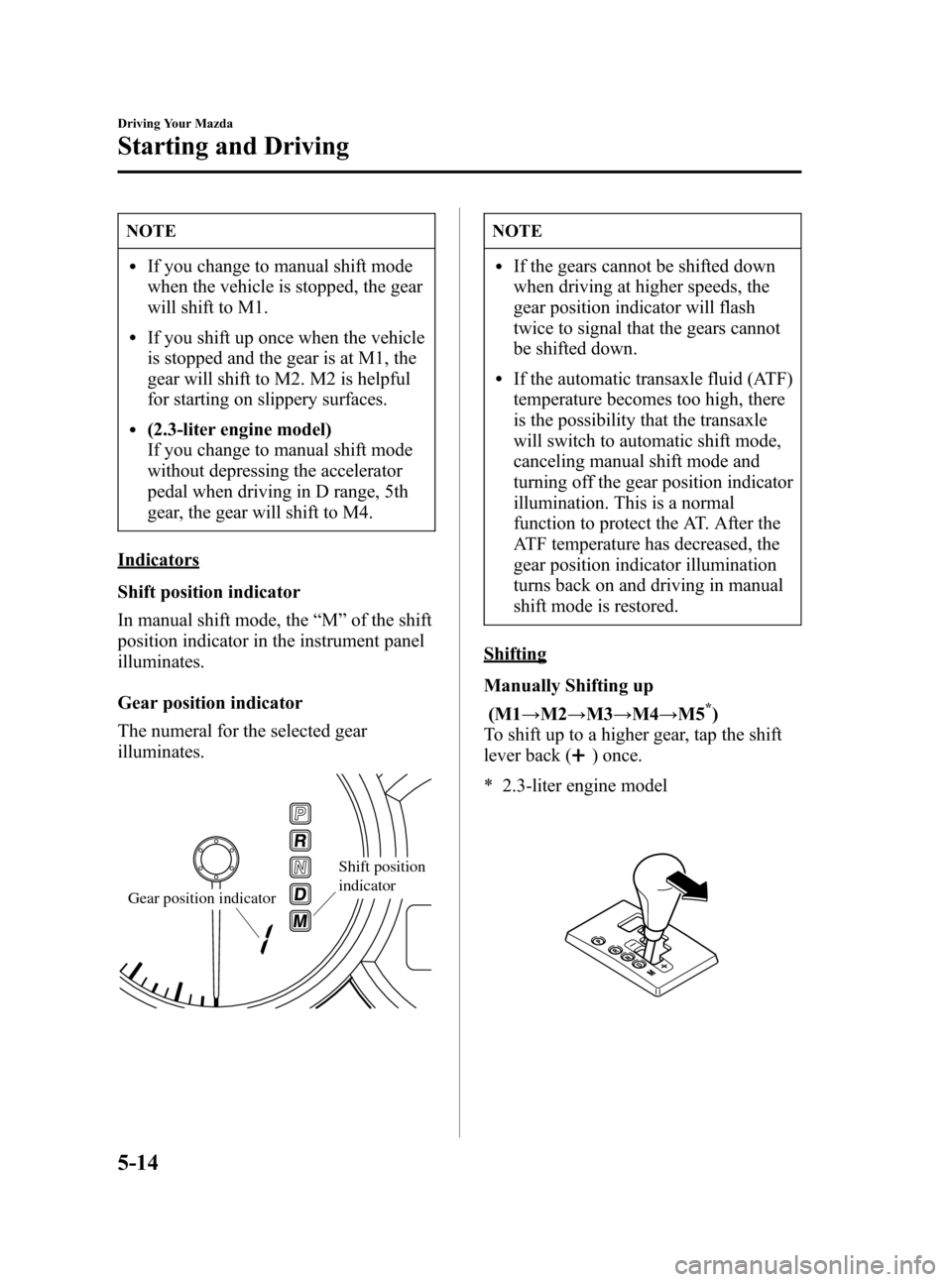
Black plate (136,1)
NOTE
lIf you change to manual shift mode
when the vehicle is stopped, the gear
will shift to M1.
lIf you shift up once when the vehicle
is stopped and the gear is at M1, the
gear will shift to M2. M2 is helpful
for starting on slippery surfaces.
l(2.3-liter engine model)
If you change to manual shift mode
without depressing the accelerator
pedal when driving in D range, 5th
gear, the gear will shift to M4.
Indicators
Shift position indicator
In manual shift mode, the“M”of the shift
position indicator in the instrument panel
illuminates.
Gear position indicator
The numeral for the selected gear
illuminates.
Shift position
indicator
Gear position indicator
NOTE
lIf the gears cannot be shifted down
when driving at higher speeds, the
gear position indicator will flash
twice to signal that the gears cannot
be shifted down.
lIf the automatic transaxle fluid (ATF)
temperature becomes too high, there
is the possibility that the transaxle
will switch to automatic shift mode,
canceling manual shift mode and
turning off the gear position indicator
illumination. This is a normal
function to protect the AT. After the
ATF temperature has decreased, the
gear position indicator illumination
turns back on and driving in manual
shift mode is restored.
Shifting
Manually Shifting up
(M1→M2→M3→M4→M5
*)
To shift up to a higher gear, tap the shift
lever back (
) once.
* 2.3-liter engine model
5-14
Driving Your Mazda
Starting and Driving
Mazda3_8V66-EA-06F_Edition3 Page136
Wednesday, August 23 2006 11:19 AM
Form No.8V66-EA-06F
Page 137 of 402
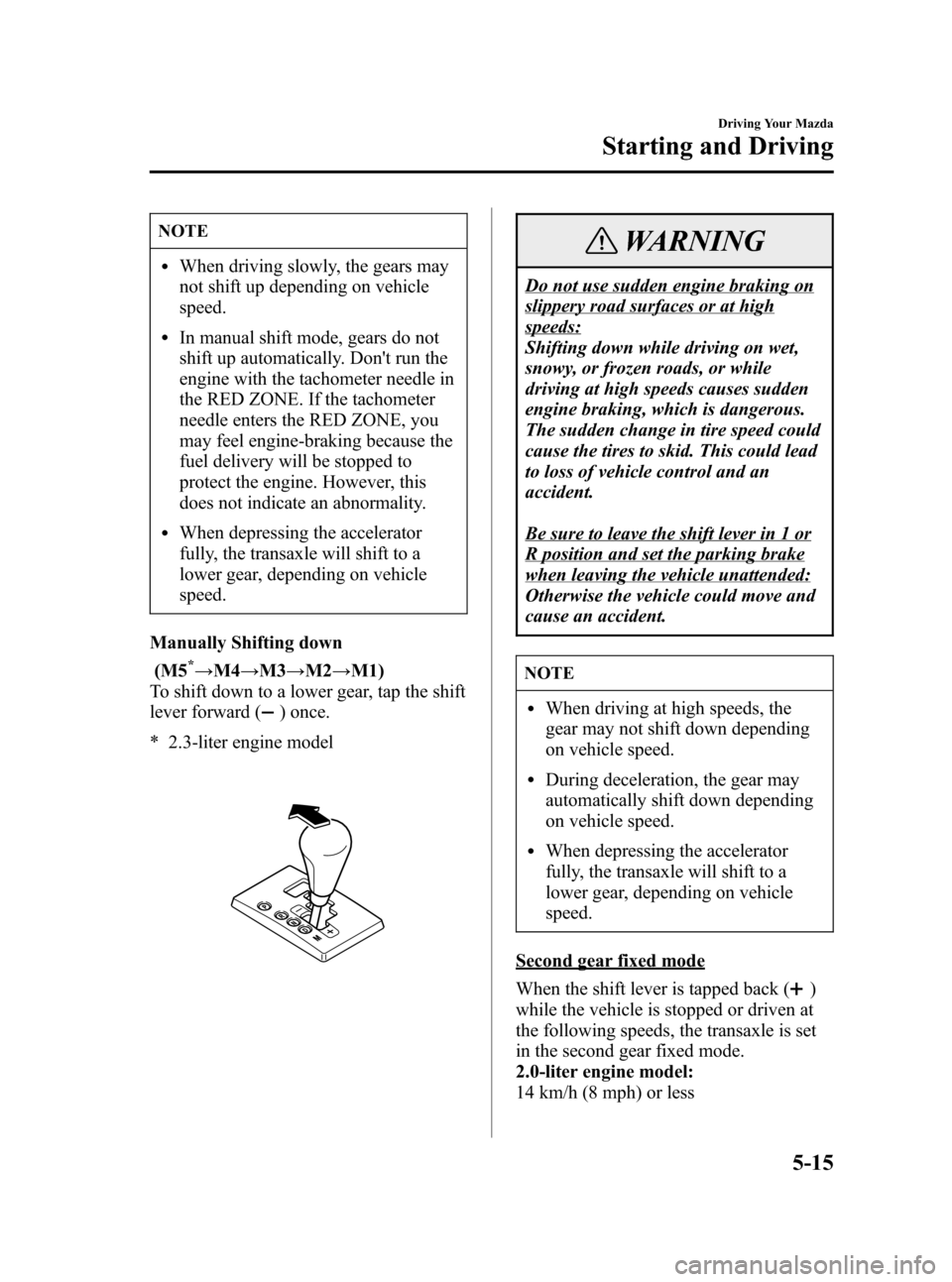
Black plate (137,1)
NOTE
lWhen driving slowly, the gears may
not shift up depending on vehicle
speed.
lIn manual shift mode, gears do not
shift up automatically. Don't run the
engine with the tachometer needle in
the RED ZONE. If the tachometer
needle enters the RED ZONE, you
may feel engine-braking because the
fuel delivery will be stopped to
protect the engine. However, this
does not indicate an abnormality.
lWhen depressing the accelerator
fully, the transaxle will shift to a
lower gear, depending on vehicle
speed.
Manually Shifting down
(M5
*→M4→M3→M2→M1)
To shift down to a lower gear, tap the shift
lever forward (
) once.
* 2.3-liter engine model
WARNING
Do not use sudden engine braking on
slippery road surfaces or at high
speeds:
Shifting down while driving on wet,
snowy, or frozen roads, or while
driving at high speeds causes sudden
engine braking, which is dangerous.
The sudden change in tire speed could
cause the tires to skid. This could lead
to loss of vehicle control and an
accident.
Be sure to leave the shift lever in 1 or
R position and set the parking brake
when leaving the vehicle unattended:
Otherwise the vehicle could move and
cause an accident.
NOTE
lWhen driving at high speeds, the
gear may not shift down depending
on vehicle speed.
lDuring deceleration, the gear may
automatically shift down depending
on vehicle speed.
lWhen depressing the accelerator
fully, the transaxle will shift to a
lower gear, depending on vehicle
speed.
Second gear fixed mode
When the shift lever is tapped back (
)
while the vehicle is stopped or driven at
the following speeds, the transaxle is set
in the second gear fixed mode.
2.0-liter engine model:
14 km/h (8 mph) or less
Driving Your Mazda
Starting and Driving
5-15
Mazda3_8V66-EA-06F_Edition3 Page137
Wednesday, August 23 2006 11:19 AM
Form No.8V66-EA-06F
Page 138 of 402
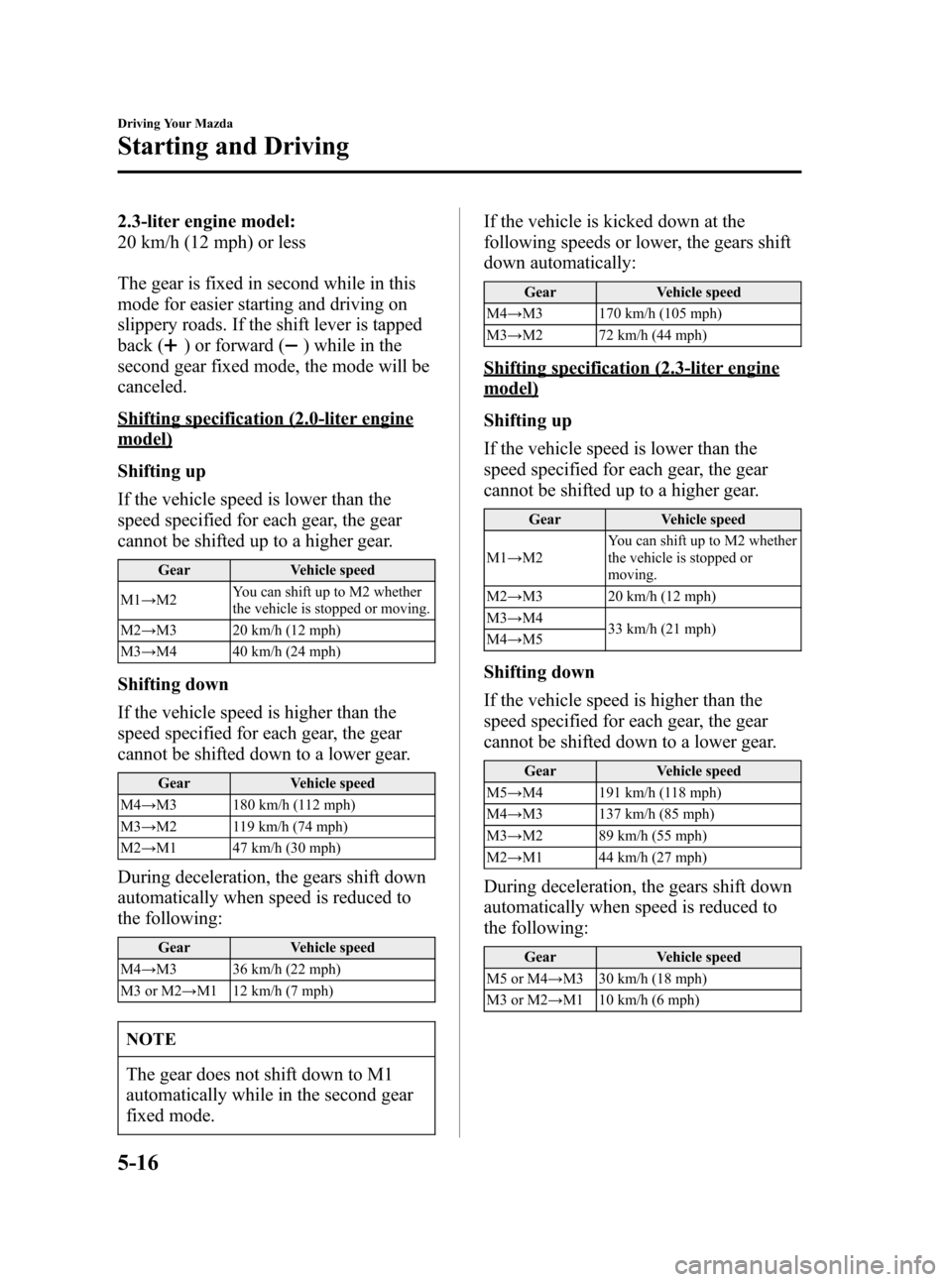
Black plate (138,1)
2.3-liter engine model:
20 km/h (12 mph) or less
The gear is fixed in second while in this
mode for easier starting and driving on
slippery roads. If the shift lever is tapped
back (
) or forward () while in the
second gear fixed mode, the mode will be
canceled.
Shifting specification (2.0-liter engine
model)
Shifting up
If the vehicle speed is lower than the
speed specified for each gear, the gear
cannot be shifted up to a higher gear.
Gear Vehicle speed
M1→M2You can shift up to M2 whether
the vehicle is stopped or moving.
M2→M3 20 km/h (12 mph)
M3→M4 40 km/h (24 mph)
Shifting down
If the vehicle speed is higher than the
speed specified for each gear, the gear
cannot be shifted down to a lower gear.
Gear Vehicle speed
M4→M3 180 km/h (112 mph)
M3→M2 119 km/h (74 mph)
M2→M1 47 km/h (30 mph)
During deceleration, the gears shift down
automatically when speed is reduced to
the following:
Gear Vehicle speed
M4→M3 36 km/h (22 mph)
M3 or M2→M1 12 km/h (7 mph)
NOTE
The gear does not shift down to M1
automatically while in the second gear
fixed mode.If the vehicle is kicked down at the
following speeds or lower, the gears shift
down automatically:
Gear Vehicle speed
M4→M3 170 km/h (105 mph)
M3→M2 72 km/h (44 mph)
Shifting specification (2.3-liter engine
model)
Shifting up
If the vehicle speed is lower than the
speed specified for each gear, the gear
cannot be shifted up to a higher gear.
Gear Vehicle speed
M1→M2You can shift up to M2 whether
the vehicle is stopped or
moving.
M2→M3 20 km/h (12 mph)
M3→M4
33 km/h (21 mph)
M4→M5
Shifting down
If the vehicle speed is higher than the
speed specified for each gear, the gear
cannot be shifted down to a lower gear.
Gear Vehicle speed
M5→M4 191 km/h (118 mph)
M4→M3 137 km/h (85 mph)
M3→M2 89 km/h (55 mph)
M2→M1 44 km/h (27 mph)
During deceleration, the gears shift down
automatically when speed is reduced to
the following:
Gear Vehicle speed
M5 or M4→M3 30 km/h (18 mph)
M3 or M2→M1 10 km/h (6 mph)
5-16
Driving Your Mazda
Starting and Driving
Mazda3_8V66-EA-06F_Edition3 Page138
Wednesday, August 23 2006 11:19 AM
Form No.8V66-EA-06F
Page 139 of 402
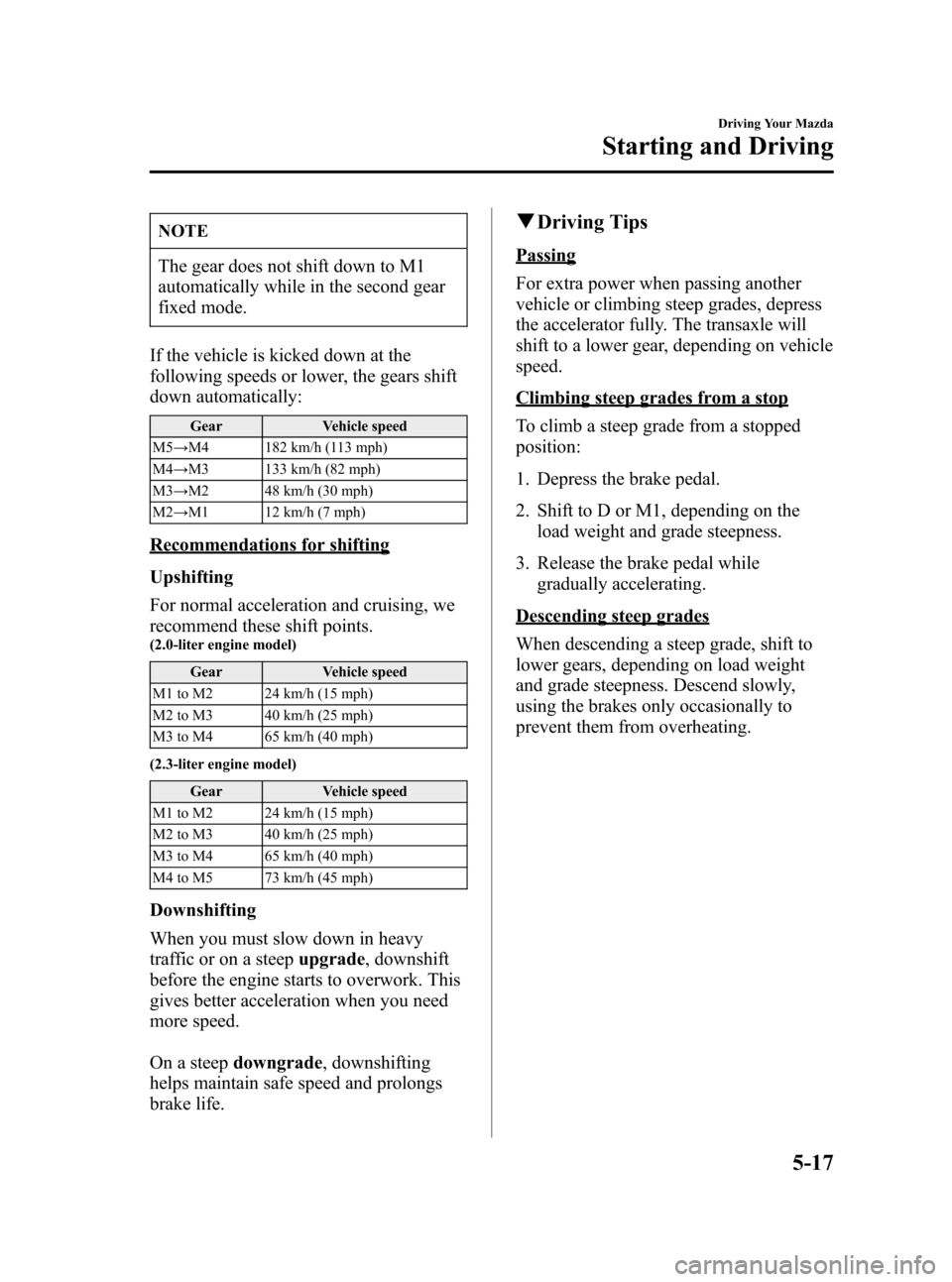
Black plate (139,1)
NOTE
The gear does not shift down to M1
automatically while in the second gear
fixed mode.
If the vehicle is kicked down at the
following speeds or lower, the gears shift
down automatically:
Gear Vehicle speed
M5→M4 182 km/h (113 mph)
M4→M3 133 km/h (82 mph)
M3→M2 48 km/h (30 mph)
M2→M1 12 km/h (7 mph)
Recommendations for shifting
Upshifting
For normal acceleration and cruising, we
recommend these shift points.
(2.0-liter engine model)
Gear Vehicle speed
M1 to M2 24 km/h (15 mph)
M2 to M3 40 km/h (25 mph)
M3 to M4 65 km/h (40 mph)
(2.3-liter engine model)
Gear Vehicle speed
M1 to M2 24 km/h (15 mph)
M2 to M3 40 km/h (25 mph)
M3 to M4 65 km/h (40 mph)
M4 to M5 73 km/h (45 mph)
Downshifting
When you must slow down in heavy
traffic or on a steepupgrade, downshift
before the engine starts to overwork. This
gives better acceleration when you need
more speed.
On a steepdowngrade, downshifting
helps maintain safe speed and prolongs
brake life.
qDriving Tips
Passing
For extra power when passing another
vehicle or climbing steep grades, depress
the accelerator fully. The transaxle will
shift to a lower gear, depending on vehicle
speed.
Climbing steep grades from a stop
To climb a steep grade from a stopped
position:
1. Depress the brake pedal.
2. Shift to D or M1, depending on the
load weight and grade steepness.
3. Release the brake pedal while
gradually accelerating.
Descending steep grades
When descending a steep grade, shift to
lower gears, depending on load weight
and grade steepness. Descend slowly,
using the brakes only occasionally to
prevent them from overheating.
Driving Your Mazda
Starting and Driving
5-17
Mazda3_8V66-EA-06F_Edition3 Page139
Wednesday, August 23 2006 11:19 AM
Form No.8V66-EA-06F
Page 140 of 402
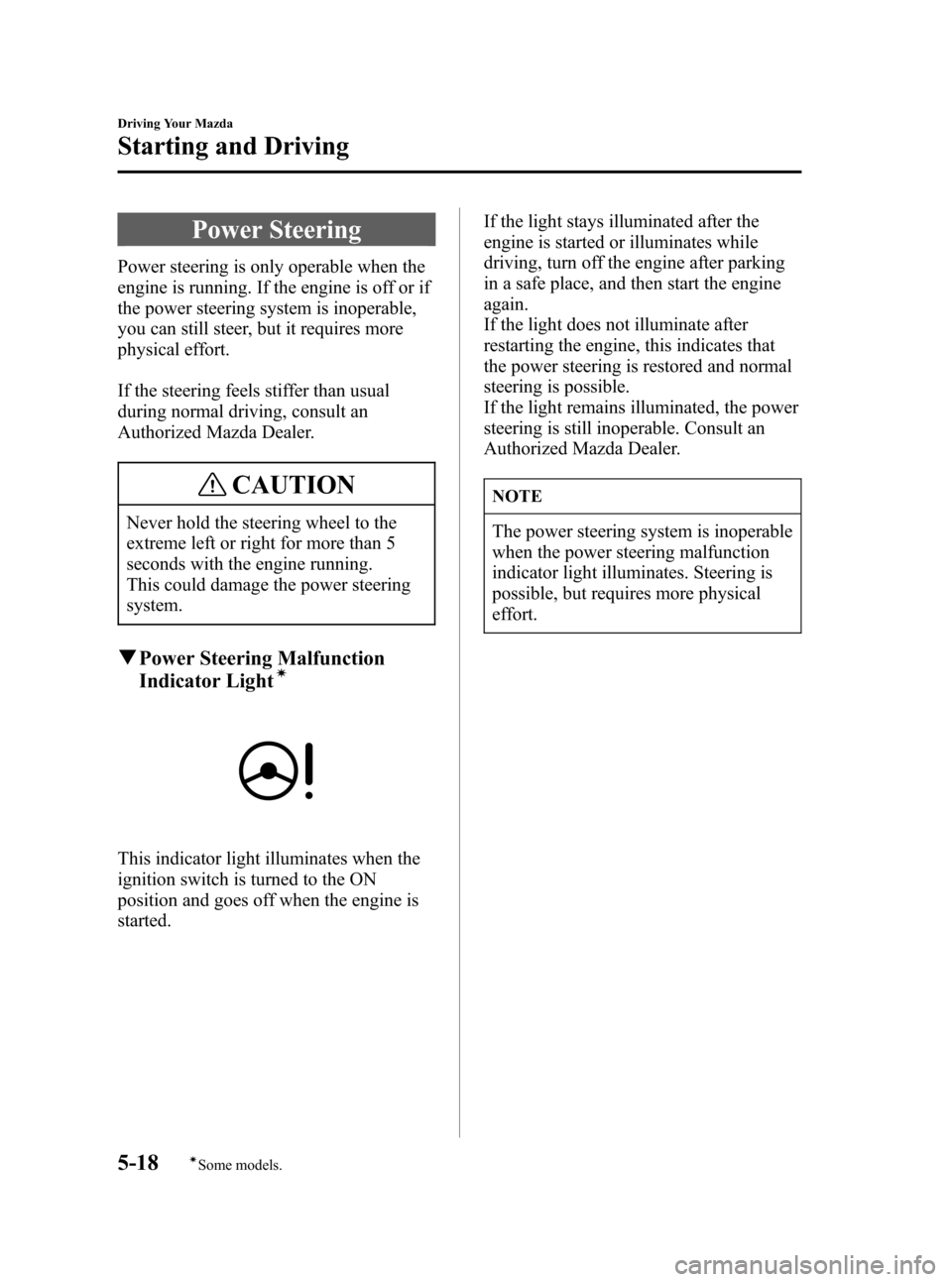
Black plate (140,1)
Power Steering
Power steering is only operable when the
engine is running. If the engine is off or if
the power steering system is inoperable,
you can still steer, but it requires more
physical effort.
If the steering feels stiffer than usual
during normal driving, consult an
Authorized Mazda Dealer.
CAUTION
Never hold the steering wheel to the
extreme left or right for more than 5
seconds with the engine running.
This could damage the power steering
system.
qPower Steering Malfunction
Indicator Lightí
This indicator light illuminates when the
ignition switch is turned to the ON
position and goes off when the engine is
started.If the light stays illuminated after the
engine is started or illuminates while
driving, turn off the engine after parking
in a safe place, and then start the engine
again.
If the light does not illuminate after
restarting the engine, this indicates that
the power steering is restored and normal
steering is possible.
If the light remains illuminated, the power
steering is still inoperable. Consult an
Authorized Mazda Dealer.
NOTE
The power steering system is inoperable
when the power steering malfunction
indicator light illuminates. Steering is
possible, but requires more physical
effort.
5-18
Driving Your Mazda
íSome models.
Starting and Driving
Mazda3_8V66-EA-06F_Edition3 Page140
Wednesday, August 23 2006 11:19 AM
Form No.8V66-EA-06F